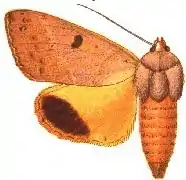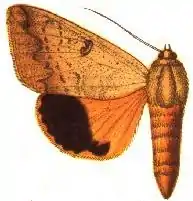Ophiusa disjungens
Ophiusa disjungens, the guava moth,[1] is a moth of the family Erebidae. The species was first described by Francis Walker in 1858. It is found in south-east Asia and the south Pacific, including Thailand, Japan, Tonga and New South Wales and Queensland. The adult is a fruit piercer.[2]
| Ophiusa disjungens | |
|---|---|
 | |
| Male | |
 | |
| Female | |
| Scientific classification | |
| Domain: | Eukaryota |
| Kingdom: | Animalia |
| Phylum: | Arthropoda |
| Class: | Insecta |
| Order: | Lepidoptera |
| Superfamily: | Noctuoidea |
| Family: | Erebidae |
| Genus: | Ophiusa |
| Species: | O. disjungens |
| Binomial name | |
| Ophiusa disjungens (Walker, 1858) | |
| Synonyms | |
| |
Description
Similar to Ophiusa discriminans, differs in head and thorax being yellowish grey. Abdomen lack black patch. Forewings yellowish grey without black specks. A maculate line runs beyond the postmedial line. A grey and dark patch beyond the sub-apical spots, and hardly a trace of the patch at anal angle. A dentate sub-marginal line with the area beyond it reddish. Hindwing orange with the black reduced to a submarginal medial patch.[3]
Larva pale brownish, with numerous waved longitudinal black lines, between which are black specks series. There are some red between each pair of legs, and a black patch between each pair of prolegs. Small pared dorsal prominences found on 11th somites. The larvae feed on various Myrtaceae species, including Eucalyptus, Syncarpia glomulifera and Psidium guajava.[4]
Gallery
 Female, dorsal view
Female, dorsal view Female, ventral view
Female, ventral view Male, dorsal view
Male, dorsal view Male, ventral view
Male, ventral view
References
- "Guava Moth - Ophiusa disjungens". Brisbane Insects and Spiders. Retrieved 21 January 2019.
- Holloway, Jeremy Daniel. "Ophiusa disjungens Walker". The Moths of Borneo. Retrieved 21 January 2019.
- Hampson, G. F. (1894). The Fauna of British India, Including Ceylon and Burma: Moths Volume II. Vol. Moths - Vol. II. Taylor and Francis – via Biodiversity Heritage Library.
- Herbison-Evans, Don & Crossley, Stella (25 March 2016). "Ophiusa disjungens (Walker, 1858) Guava Moth". Australian Caterpillars and their Butterflies and Moths. Retrieved 21 January 2019.
External links
- Japanese Moths
- Characterization of the deoxyuridine triphosphatase gene of Ophiusa disjungens nucleopolyhedrovirus.